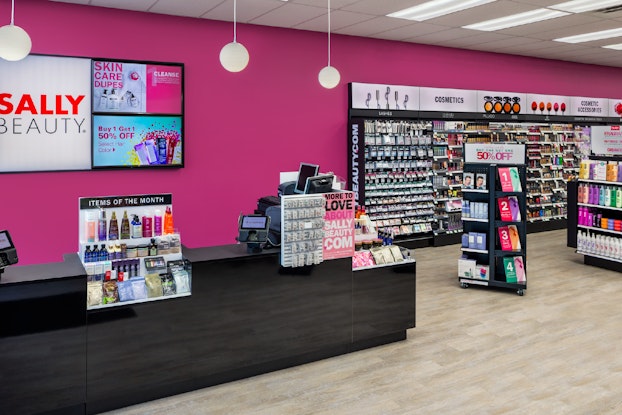
Why in matters:
- In a tight labor market, managing workers and payrolls has become more important than ever.
- COVID-19 greatly increased the amount of information that needs to be shared with store employees on a daily basis.
- Sally Beauty has seen store conversion rates improve as it has improved task management.
Sally Beauty Holdings, Inc. faced a challenge retailers both large and small can relate to: Its workforce management and task management systems were out of date and needed a serious upgrade. David Hamilton, who helped solve the problem and implement the solutions, first as a member of Sally Beauty’s IT team, then as director of stores for the company’s consumer retail store division, and now as a director of operations for the company’s CosmoProf professional beauty supply stores, talked to CO— about how Sally Beauty tackled this challenge and the impact on the business.
The problem: ‘Everything was very manual’
Sally Beauty Holdings, which has close to 5,000 stores, including 2,900 Sally Beauty stores and more than 1,300 CosmoProf and Armstrong-McCall stores that sell to professional salons and industry professionals, realized in 2016 that it needed a way to modernize how it was keeping track of employee schedules and ensuring that tasks like price changes, as well as stock resets, were completed.
“Everything was very manual,” Hamilton said. “We had no way to measure task completion – any task that we needed to have follow-up on. We’d have to call every store and say, ‘Hey, have you finished this yet?’” he said.
In addition, staffing schedules were all done on paper. If district managers wanted to see a store’s schedule, a store employee had to take a picture of it and send it to them.
In terms of tracking payroll, “we didn’t know until after the week ended how much payroll we used, and in some cases until after the month ended,” Hamilton said.
They also needed a way to make training materials and product information easily accessible for store employees.
[How 3 Brands Tapped Tech to Slay Order Management and Reduce Labor Costs in a Post-COVID World]
The solution: a ‘crawl, walk and run’ strategy
Sally Beauty went to the annual National Retail Federation trade show looking for a task management system and a workforce management system. It chose a platform by tech company Reflexis, now a division of Zebra Technologies, because it could provide both task management and workforce management jobs such as scheduling and payroll tracking, as well as store training documents.
Employees in each store have mobile tablets loaded with the Reflexis programs, which they use during the workday.
Sally Beauty staggered the implementation of the systems over about three years, using a strategy Hamilton described as “crawl, walk, run.” The retailer started with task management functions, then it moved all documents into the platform, then added tools such as virtual store walks for managers and notifications to assist in-store and curbside pickups.
You have to spend time understanding store operations and eliminate the tasks that take associates away from customer-facing time.
David Hamilton, director of store operations, Sally Beauty
The impact: sales conversion lift and better customer service
The new platform was installed as Sally Beauty was in the midst of a reorganization that increased the workload of each district manager from 12 stores to 20 stores. The reorganization meant managers could not physically get to every store, “so it was important for them to have the ability to [virtually] see what’s happening in each of their stores,” Hamilton said.
The task management system allows them to see whether all of their stores have completed tasks, and target underperforming stores for additional help.
Store employees, when they have completed a task, such as changing a display, can upload a picture showing the completed job.
Store managers and district managers can take a virtual walk through the store and see a check list of completed tasks.
“We used to say, ‘Get this done in two weeks.’ Well, we never knew if it was done in two weeks or not,” Hamilton said. “Now we are able to track how things are doing and how the store is performing.”
The combined task force management and workforce management capabilities of the platform have helped the company better align workloads with staffing, to make sure there are enough employees available to help customers. That has resulted in improved conversion rates – the percentage of customers who make purchases – and improved contact with customers.
The new programs also helped Sally Beauty accelerate its in-store pickup and curbside pickup business at a critical time during the pandemic. The CosmoProf division went from having 25 stores that offered same-day delivery to over 1,000 stores within a few months, for example.
The document repository in the platform also proved valuable in getting COVID-19 safety information to store employees. “We created 30- to 40-page playbooks for the stores with new safety protocols,” Hamilton said.
[The Changing Playbook for Winning Customer Loyalty All Marketers Should Know]
Key lessons: ‘It can support the smallest business to the largest business’
To get employees on board with new technology, you have to make sure you get the “what’s-in-it-for-me message” across to employees, Hamilton said.
Before rolling out the new programs, Sally Beauty did a lot of communicating with employees about how the technology could streamline their jobs and make the stores more efficient.
“Any new system requires change management and ensuring that you get the buy-in from the associates. So, we started early and often, communicating about the fact that it was coming and what it would do for them,” Hamilton said.
With its stores, Sally Beauty in a sense operates 5,000 small businesses, and task management and workforce technology are as important for small businesses as they are for national chains, he said.
“It can support the smallest business to the largest business,” Hamilton said. “We all have the same opportunity, and it’s about getting everybody to execute at the same time, and execute flawlessly, and you can’t do that without some type of task management system,” he said. For payroll and workforce management, laws and policies have become so complex that you can’t do it manually today, he said.
The best way to boost productivity, Hamilton has learned, is to “eliminate those mundane tasks, and get to the things that are key.”
“You have to spend time understanding store operations and eliminate the tasks that take associates away from customer-facing time,” he said.
CO— aims to bring you inspiration from leading respected experts. However, before making any business decision, you should consult a professional who can advise you based on your individual situation.
Follow us on Instagram for more expert tips & business owners’ stories.
CO—is committed to helping you start, run and grow your small business. Learn more about the benefits of small business membership in the U.S. Chamber of Commerce, here.
CO— Exclusives: Insider Strategies
How the buzziest brands and hottest startups are solving today's biggest business challenges. CO— brings you advice from startup founders and top executives for thriving in a new world.








